If you collect any one thing for long enough eventually that thing will start to find you. People will know your that guy and just give you those things. You might end up with some really rare stuff for cheap, or you might end up with 1000 copies of Jurassic Park on VHS. Only the Gods will know your fate.
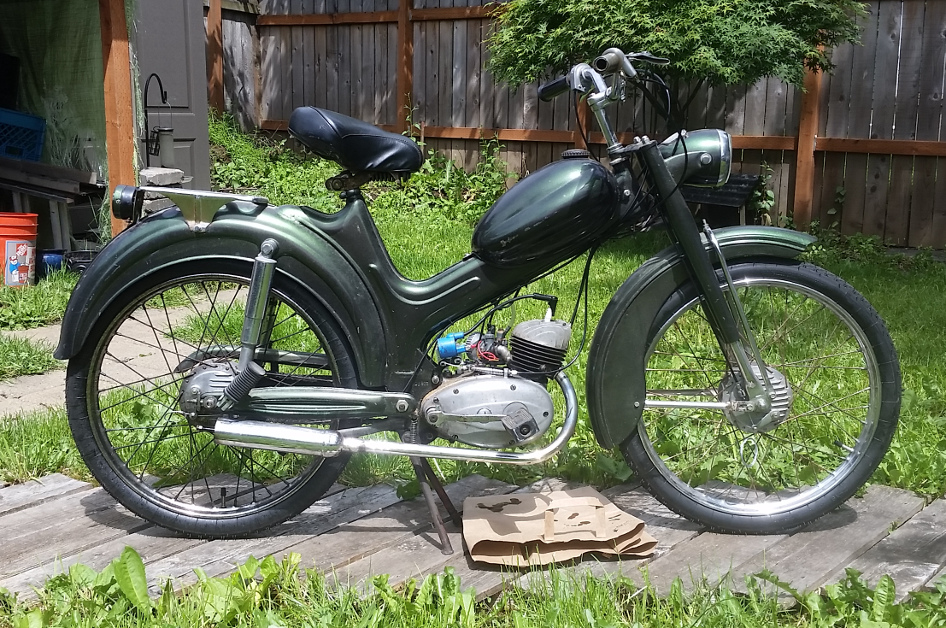
One day a friend of mine texted me and told me he wanted to give me a bike he had been storing for about a decade. I knew the bike, it was kept in his living room. We had talked about it many times because he had tasked me to find out what model it was and frankly I couldn’t. When he decided to get rid of it he felt he couldn’t sell it. He also decided it needed to go to a home that would appreciate it and take care of it. So I got the call.

And oh man was I excited. But at that specific time I didn’t have the extra money or time to dive into it. I shelved it for a bit but I did try to look for identifying markers. At some point, late 80’s to early 90’s based on the color, it had been repainted with a purple/green color flip paint. Pretty nicely too. It was a complete teardown, strip, and paint. Honestly the paint still looks really good and it is the first time I’ve ever seen this kind of paint look good on a bike. The large amount of curved surfaces really pop with the shifting colors, even after all these years ( and I realize these pics don’t display the effect very well but in person it’s nice). The downside is they also removed all decals and stickers on the bike. The only remaining factory information is the engine tag, which only has the engine information, and what I believe is the VIN number. The engine tag indicates it is a Halleiner Motorenwerke Type HMW 50N, 1956.
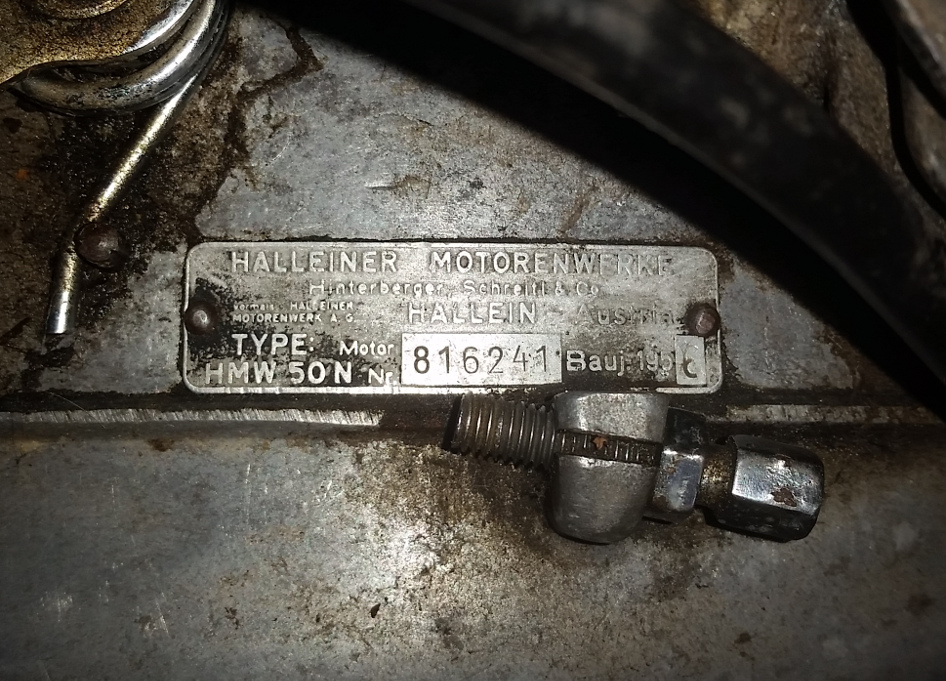
A little bit of research tells determined that was actually just the motor model and not the bike model. It also told me the company HMW made their own bikes but also sold their engines to other manufacturers to be used so without having frame indicators it could be a couple of different brands. The motor company also only existed from 1948 to 1962 and I don’t know if they were ever sold in the states or if this was an imported bike. I have no title and no indication they were sold here but for that long ago records for moped sales are very scarce. So the only way I was going to determine the model was to picture match to websites.
This bike is in wonderful condition for its age. Almost every part of the bike is original. So I took pictures of all the specific parts of the bike that seemed unique and started looking around. My first problem is all websites for this type of bike seem to be European which makes it much harder to search for information. Luckily I was able to find one really good website called HMW Zweirad, an Austrian website with a great deal of information which now acts as my primary source. No luck though, because their model list does not have matching features. Some of them are very close but not exactly. I found a list of companies that use HMW motors but all are fairly obscure and combined with language barriers I may not be finding the info I need. HMW sold motors to: Avada, Delta Gnom, Vesting, Typhoon, Gazelle, Maxwell, Sarolea, l’Avenir, Salira, Cimatti and Gresvig. I searched all of them but struck out. Eventually I found this page with the only matching frame details I’ve seen. Problem is this page lists the model as a HMW 50SS, but this pictures on the Zweirad for the same model do not match even a little. So I am not so sure. But unless I find more information or someone contacts me and corrects me it’s the best I’ve got. So I’m sticking to it.
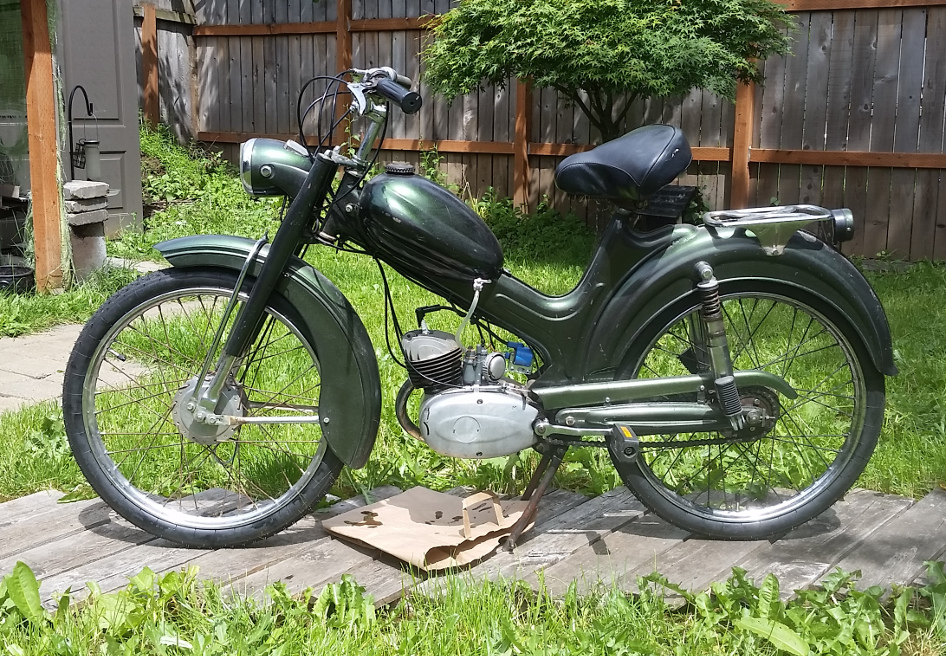
The research done, the bike sat for about a year and a half waiting for the right time. Then the Covid restrictions came and I found myself with no job and a lot of time at home, perfect conditions really. I was told the bike ran when the last owner first got it. He connected a VW beetle ignition coil to it and would ride it around. He found it too slow to go on rides with other people and that’s when it got placed in the living room.
I started with the basics; a compression test, a leak down test, carb clean, tank inspections and fuel valve replace, new fuel line, new tires, new cables, change the case oil, clean and adjust points, and rebuild the loose bearing wheel bearings. The only issues I had was the ignition system. It is a Bosch internal coil ignition that had been converted at some point to be an external high tension coil. Problem is the frame had no location for an external coil to mount. I cut up an old E50 clutch brace and mounted a universal 6V points coil to it and hooked up the existing wire from the ignition and it worked ok. The spark strength was too weak to be picked up with my timing light but still seemed to run fine. There was some marks on the flywheel and case that I used as my timing marks and it seemed to run well at that timing so I left it there.

The carb is something that I wanted to talk about. It is a Dellorto but unlike anything I’ve seen before. It has a single, main jet that is spring loaded to hold itself in place, it threads in at an angle and uses a unique jet system. There is no other jets or passages on the carb. The slide does have a needle but there is no way to adjust the needle setting. In fact the needle is actually used to hold the throttle cable in place. The end of the cable has to be filed down to fit inside of the holder perfectly to keep the needle from rattling around. My favorite part of the carb is the choke system. The front of the carb is a filter housing that rotates. This rotation opens and closes an air passage that is used to lean out the main jet system to operate as a choke. But it’s reverse of what you assume. Rotated to be on full choke it actually blocks the passage off so the main jet pulls it’s full volume through it. When you turn the choke off it opens the passage up and leans out the main jet to bring it down to running jetting. The slot is tapered as well so as you rotate it smoothly transitions between full choke and full run. In practice this let me basically perfectly tune the carb as I rode it around and frankly I loved this. I want more carbs with the ability for me to tune on the road while I ride. It also has a brass float with brass on brass needle valve system and I was able to reseal it by using a grinding compound made from baking soda toothpaste and some time. Other than cutting some new gaskets the carb is as factory as I could get and honestly it worked much better than I expected it too. Plus it looks great too.
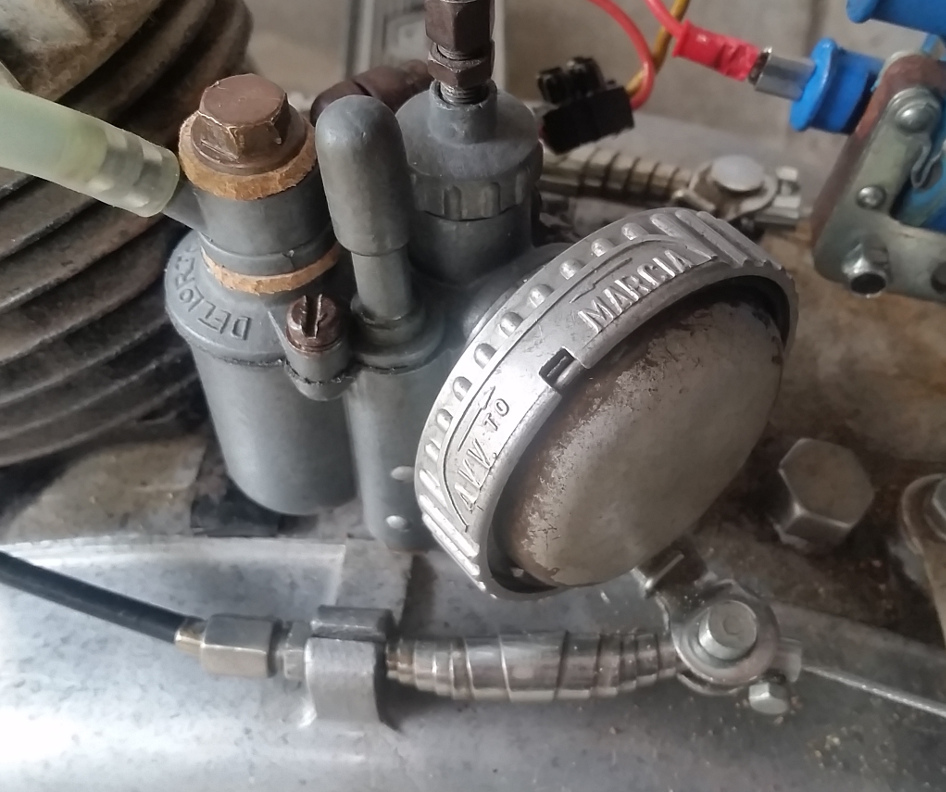
This bike is full of weird details that I love. The motor is a 2-speed manual 50cc 2 stroke, piston port with an inboard pedal system. The frame uses standard throttle on the right, brake lever on the right, clutch and twist hand shift on the left. The pedals are on the engine and operate at all times. The shifter is 1st gear forward, neutral in the middle, and 2nd gear back. If you are familiar with hand shift systems from other bikes you know they typically run two cables so that when you rotate a cable will pull the mechanism into the next position. This system is different in that it only uses one cable and the transmission is spring loaded in the motor. The spring forces the transmission into 2nd gear and has to be pulled down into neutral and then into first. If the cable looses tension it will shift up automatically. The second odd thing is it has no positive position retention system in the motor. The lever arm moves smoothly between all 3 positions, or any position in between. The positioning is controlled by a gated lever assembly on the bar. The clutch has a extra tab that locates into 3 different gates on the built into the rotating assembly. You have to spend some time adjusting the cable to locate the 3 positions on the transmission accurately or you will grind the gears. It works but it’s not clean and it is very sensitive to misadjustments and wear. Also if you break the factory assembly you can’t replace it easily. You can tell this became a problem as some point in this bikes history because the clutch lever has been welded back together. The other fun oddity is the front brake lever. On most bikes like this they use a coaster brake system for the rear but not this bike. It actually runs both brake cables from just the front brake lever. I’ve never seen this before and it’s crazy they did it, but the bike is slow enough they probably figure it wouldn’t matter. I love it though. To start the bike you hold the clutch in and rotate to 1st, rotate the air filter to “AVV to”, pedal, then drop the clutch until it starts. It had no electrical controls so I kill the motor with the clutch as well. So far I’ve had no issues.
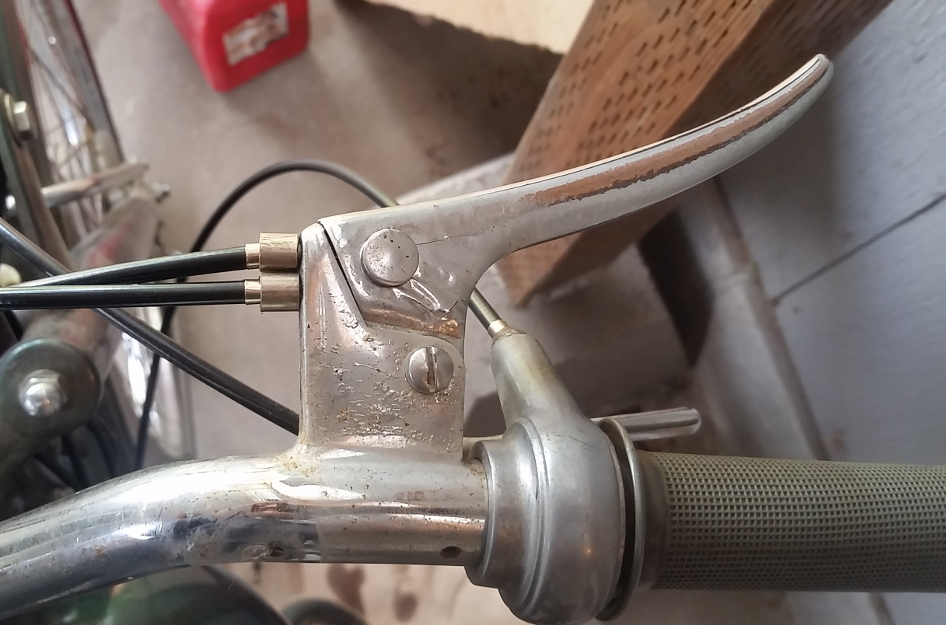
How does it run? Shockingly well. I’m only missing one important part and it is the cap for the back of the muffler so it’s really loud and probably losing a little bit of power. And I’m also judging this bike on a sliding scale due to the age and condition. It starts easy, does 30 on flat ground in 2nd, and can pull an ok grade in 1st. All the lights work with no issues and it handles and rides very smoothly. I love riding this thing around the neighborhood. I haven’t gone on a long ride and since society has been in lockdown since I got it running I haven’t really been able to show it off at ride ins and coffee shops. It’s too rare to really ride it a lot but it’s in such good shape that I will absolutely ride it more when the world gets less shut in.

If you for some reason know more about this thing or can tell me what I’ve gotten wrong please let me know, I’d love to learn more about it. Or if you have the muffle cap for the end, that would make all me neighbors happy.

Hi, i think i have same moped and model. It have some little differentials in details but it looks just same model. Im founded some spare parts to it. Yesterday i ordered new clutch disks from austria and there is one webshop at sweden where was some parts. I could send you some photos of mine moped if you want.